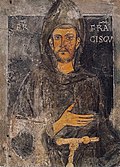Franciscans
Ordo Fratrum Minorum | |
 A cross, Christ's arm and Saint Francis's arm, a universal symbol of the Franciscans[1] | |
| Abbreviation | OFM |
|---|---|
| Formation | 24 February 1209 |
| Founder | Francis of Assisi |
| Type | Mendicant Order of Pontifical Right for men[2] |
| Headquarters | Via S. Maria Mediatrice 25, 00165 Rome, Italy |
Membership | 12,476 members (8,512 priests) as of 2020[2] |
Motto | Pax et bonum(Latin) Peace and [all] good |
Minister General | Massimo Fusarelli[2] |
Parent organization | Catholic Church |
| Subsidiaries | Secular Franciscan Order(1221) Third Order of Saint Francis(1447) |
| Secessions | OFM(1897) OFM Conventual(1517) OFM Capuchin(1520) |
Formerly called | Order of Observant Friars Minor[2] |

TheFranciscansare a group of relatedmendicantreligious ordersof theCatholic Church.[3]Founded in 1209 by the Italian saintFrancis of Assisi,these orders include three independent orders for men (theOrder of Friars Minorbeing the largest contemporary male order), orders fornunssuch as theOrder of Saint Clare,and theThird Order of Saint Francisopen to male and female members. They adhere to the teachings and spiritual disciplines of the founder and of his main associates and followers, such asClare of Assisi,Anthony of Padua,andElizabeth of Hungary.Several smallerProtestant Franciscanorders or other groups have been established since late 1800's as well, particularly in theAnglicanandLutherantraditions.[4][better source needed]
Francis began preaching around 1207 and traveled toRometo seek approval fromPope Innocent IIIin 1209 to form a new religious order. The originalRule of Saint Francisapproved by the Pope did not allow ownership of property, requiring members of the order to beg for food while preaching. The austerity was meant to emulate the life and ministry ofJesus Christ.Franciscans traveled and preached in the streets, while staying in church properties.Clare of Assisi,under Francis's guidance, founded thePoor Clares(Order of Saint Clare) of the Franciscans.
The extreme poverty required of members was relaxed in the final revision of the Rule in 1223. The degree of observance required of members remained a major source of conflict within the order, resulting in numerous secessions.[5][6]The Order of Friars Minor, previously known as the "Observant" branch, is one of the three FranciscanFirst Orderswithin the Catholic Church, the others being the "Conventuals"(formed 1517) and"Capuchins"(1520). The Order of Friars Minor, in its current form, is the result of an amalgamation of several smaller orders completed in 1897 byPope Leo XIII.[7]The latter two, the Capuchin and Conventual, remain distinctreligious instituteswithin the Catholic Church, observing theRule of Saint Franciswith different emphases. Conventual Franciscans are sometimes referred to asminoritesorgreyfriarsbecause of theirhabit.InPolandandLithuaniathey are known asBernardines,afterBernardino of Siena,although the term elsewhere refers toCisterciansinstead.

Name and demographics[edit]

The name of the original order,Ordo Fratrum Minorum(Friars Minor, literally 'Order of Lesser Brothers') stems from Francis of Assisi's rejection of luxury and wealth. Francis was the son of a rich cloth merchant, but gave up his wealth to pursue his faith more fully. He had cut all ties that remained with his family, and pursued a life living in solidarity with his fellow brothers in Christ.[8]In other words, he abandoned his life among the wealthy and aristocratic classes (orMajori) to live like the poor and peasants (minori). Francis adopted the simple tunic worn by peasants as thereligious habitfor his order, and had others who wished to join him do the same. Those who joined him became the original Order of Friars Minor.[1]
First Order[edit]
The First Order or the Order of Friars Minor, orSeraphic Order[9]are commonly called simply theFranciscans.This order is amendicantreligious orderof men, some of whom trace their origin to Francis of Assisi.[10]Their officialLatinname is theOrdo Fratrum Minorum.[11]Francis thus referred to his followers as "Fraticelli", meaning "Little Brothers". Franciscan brothers are informally calledfriarsor theMinorites.[12]
The modern organization of the Friars Minor comprises three separate families or groups, each considered a religious order in its own right under its own minister General and particular type of governance. They all live according to a body of regulations known as the Rule of Saint Francis.[10]
- TheOrder of Friars Minor,also known as the Observants, are most commonly simply calledFranciscan friars,[10]official name: Friars Minor (OFM).[12]
- TheOrder of Friars Minor Capuchinor simplyCapuchins,[10]official name: Friars Minor Capuchin (OFM Cap.).[12]
- TheOrder of Friars Minor Conventualor simplyMinorites,[10]official name: Friars Minor Conventual (OFM Conv.).[12]
Second Order[edit]
The Second Order, most commonly calledPoor Claresin English-speaking countries, consists of only one branch of religious sisters. The order is called the Order of St. Clare (OSC), but prior to 1263 they were called "The Poor Ladies", "The Poor Enclosed Nuns", and "The Order of San Damiano".[13]
Third Order[edit]
The Franciscanthird order,known as theThird Order of Saint Francis,has many men and women members, separated into two main branches:
- TheSecular Franciscan Order,OFS, originally known as the Brothers and Sisters of Penance or Third Order of Penance, try to live the ideals of the movement in their daily lives outside ofreligious institutes.
- Members of theThird Order Regular(TOR) live in religious communities under the traditionalreligious vows.They grew out of the Secular Franciscan Order.
The 2013Annuario Pontificiogave the following figures for the membership of the principal male Franciscan orders:.[14]
- Order of Friars Minor (OFM): 1,915 communities; 12,476 members (including 8,512 priests)
- Franciscan Order of Friars Minor Conventual (OFM Conv.): 572 communities; 3,981 members (including 2,777 priests)
- Franciscan Order of Friars Minor Capuchin (OFM Cap.): 1,542 communities; 10,355 members (including 6,796 priests)
- Third Order Regular of Saint Francis (TOR): 147 communities; 813 members (including 581 priests)
The coat of arms that is a universal symbol of Franciscan "contains theTau cross,with two crossed arms: Christ's right hand with the nail wound and Francis' left hand with the stigmata wound. "[1]
History[edit]
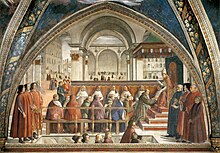
Beginnings[edit]
A sermon Francis heard in 1209 onMatthew 10:9made such an impression on him that he decided to devote himself wholly to a life of apostolic poverty. Clad in a rough garment, barefoot, and, after theEvangelicalprecept, without staff or scrip, he began to preach repentance.[15]
He was soon joined by a prominent fellow townsman,Bernard of Quintavalle,who contributed all that he had to the work, and by other companions, who are said to have reached the number of eleven within a year. The brothers lived in the desertedleper colonyof Rivo Torto nearAssisi;but they spent much of their time traveling through the mountainous districts ofUmbria,always cheerful and full of songs, yet making a deep impression on their hearers by their earnest exhortations. Their life was extremely ascetic, though such practices were apparently not prescribed by the first rule which Francis gave them (probably as early as 1209) which seems to have been nothing more than a collection of Scriptural passages emphasizing the duty of poverty.[16]
In spite of some similarities between this principle and some of the fundamental ideas of the followers ofPeter Waldo,the brotherhood of Assisi succeeded in gaining the approval ofPope Innocent III.[17]What seems to have impressed first theBishop of Assisi,Guido, thenCardinalGiovanni di San Paoloand finally Innocent himself, was their utter loyalty to the Catholic Church and the clergy. Innocent III was not only the pope reigning during the life of Francis of Assisi, but he was also responsible for helping to construct the church Francis was being called to rebuild. Innocent III and the Fourth Lateran Council helped maintain the church in Europe. Innocent probably saw in them a possible answer to his desire for an orthodox preaching force to counter heresy. Many legends have clustered around the decisive audience of Francis with the pope. The realistic account inMatthew Paris,according to which the pope originally sent the shabby saint off to keep swine, and only recognized his real worth by his ready obedience, has, in spite of its improbability, a certain historical interest, since it shows the natural antipathy of the olderBenedictine monasticismto the plebeian mendicant orders. The group wastonsuredand Francis was ordained as a deacon, allowing him to proclaim Gospel passages and preach in churches during Mass.[18]
Francis's last years[edit]
Francis had to suffer from the dissensions just alluded to and the transformation they effected in the original constitution of the brotherhood making it a regular order under strict supervision from Rome. Exasperated by the demands of running a growing and fractious Order, Francis askedPope Honorius IIIfor help in 1219. He was assigned CardinalUgolinoas protector of the Order by the pope. Francis resigned the day-to-day running of the Order into the hands of others but retained the power to shape the Order's legislation, writing a Rule in 1221 which he revised and had approved in 1223. After about 1221, the day-to-day running of the Order was in the hands of BrotherElias of Cortona,an able friar who was elected as leader of the friars a few years after Francis's death (1232) but who aroused much opposition because of his autocratic leadership style.[19]He planned and built theBasilica of San Francesco d'Assisiin whichFrancis of Assisiis buried, a building which includes the friarySacro Convento,still today the spiritual centre of the Order.[20]
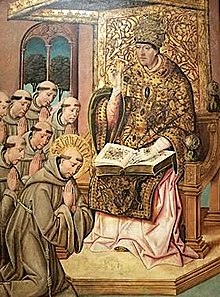
In the external successes of the brothers, as they were reported at the yearly general chapters, there was much to encourage Francis.Caesarius of Speyer,the first Germanprovincial,a zealous advocate of the founder's strict principle of poverty, began in 1221 fromAugsburg,with twenty-five companions, to win for the Order the land watered by theRhineand theDanube.In 1224Agnellus of Pisaled a small group of friars to England. The branch of the Order arriving in England became known as the "greyfriars".[21]Beginning atGreyfriarsatCanterbury,the ecclesiastical capital, they moved on toLondon,the political capital, andOxford,the intellectual capital. From these three bases the Franciscans swiftly expanded to embrace the principal towns of England.
Dissensions during Francis's life[edit]
The controversy about how to follow the Gospel life of poverty, which extends through the first three centuries of Franciscan history, began in the lifetime of the founder. The ascetic brothers Matthew ofNarniand Gregory of Naples, a nephew ofCardinal Ugolino,were the two vicars-general to whom Francis had entrusted the direction of the order during his absence. They carried through at a chapter which they held certain stricter regulations in regard to fasting and the reception of alms, which departed from the spirit of the original rule. It did not take Francis long, on his return, to suppress this insubordinate tendency but he was less successful in regard to another of an opposite nature which soon came up.Elias of Cortonaoriginated a movement for the increase of the worldly consideration of the Order and the adaptation of its system to the plans of the hierarchy which conflicted with the original notions of the founder and helped to bring about the successive changes in the rule already described. Francis was not alone in opposition to this lax and secularizing tendency. On the contrary, the party which clung to his original views and after his death took his "Testament" for their guide, known as Observantists orZelanti,was at least equal in numbers and activity to the followers of Elias.
Custody of the Holy Land[edit]
After an intense apostolic activity in Italy, in 1219 Francis went toEgyptwith theFifth Crusadeto announce theGospelto theSaracens.He met with the SultanMalik al-Kamil,initiating a spirit of dialogue and understanding betweenChristianityandIslam.The Franciscan presence in the Holy Land started in 1217, when the province ofSyriawas established, with Brother Elias as Minister. By 1229 the friars had a small house near the fifth station of theVia Dolorosa.In 1272 sultanBaibarsallowed the Franciscans to settle in theCenacleonMount Zion.Later on, in 1309, they also settled in theHoly Sepulchreand inBethlehem.In 1335 the king of NaplesRobert of Anjou(Italian:Roberto d'Angiò) and his wifeSancha of Majorca(Italian:Sancia di Maiorca) bought the Cenacle and gave it to the Franciscans.Pope Clement VIby the BullsGratias agimusandNuper charissimae(1342) declared the Franciscans as the official custodians of the Holy Places in the name of the Catholic Church.
The FranciscanCustody of the Holy Landis still in force today.[22]
Development after Francis's death[edit]
Development to 1239[edit]

Elias was a lay friar, and encouraged other laymen to enter the order. This brought opposition from many ordained friars and ministers provincial, who also opposed increased centralization of the Order.Gregory IXdeclared his intention to build a splendid church to house the body of Francis and the task fell to Elias, who at once began to lay plans for the erection of a great basilica at Assisi, to enshrine the remains of thePoverello.[19]In order to build the basilica, Elias proceeded to collect money in various ways to meet the expenses of the building. Elias thus also alienated the zealots in the order, who felt this was not in keeping with the founder's views upon the question of poverty.
The earliest leader of the strict party wasBrother Leo,a close companion of Francis during his last years and the author of theSpeculum perfectionis,a strong polemic against the laxer party. Having protested against the collection of money for the erection of the basilica of San Francesco, it was Leo who broke in pieces the marble box which Elias had set up for offertories for the completion of the basilica atAssisi.For this Elias had him scourged, and this outrage on St Francis's dearest disciple consolidated the opposition to Elias. Leo was the leader in the early stages of the struggle in the order for the maintenance of St Francis's ideas on strict poverty.[23]At the chapter held in May 1227, Elias was rejected in spite of his prominence, andGiovanni Parenti,Minister Provincial of Spain, was elected Minister General of the order.
In 1232 Elias succeeded him, and under him the Order significantly developed its ministries and presence in the towns. Many new houses were founded, especially in Italy, and in many of them special attention was paid to education. The somewhat earlier settlements of Franciscan teachers at the universities (inParis,for example, whereAlexander of Haleswas teaching) continued to develop. Contributions toward the promotion of the Order's work, and especially the building of the Basilica in Assisi, came in abundantly. Funds could only be accepted on behalf of the friars for determined, imminent, real necessities that could not be provided for from begging. When in 1230, the General Chapter could not agree on a common interpretation of the 1223 Rule it sent a delegation includingAnthony of PaduatoPope Gregory IXfor an authentic interpretation of this piece of papal legislation. The bullQuo elongatiof Gregory IX declared that the Testament of St. Francis was not legally binding and offered an interpretation of poverty that would allow the Order to continue to develop. Gregory IX authorized agents of the Order to have custody of such funds where they could not be spent immediately. Elias pursued with great severity the principal leaders of the opposition, and evenBernardo di Quintavalle,the founder's first disciple, was obliged to conceal himself for years in the forest ofMonte Sefro.
The conflict between the two parties lasted many years and theZelantiwon several notable victories in spite of the favor shown to their opponents by the papal administration, until finally the reconciliation of the two points of view was seen to be impossible and the order was actually split into halves.
1239–1274[edit]
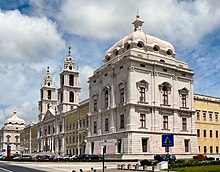
Elias governed the Order from the center, imposing his authority on the provinces (as had Francis). A reaction to this centralized government was led from the provinces of England and Germany. At the general chapter of 1239, held in Rome under the personal presidency of Gregory IX, Elias was deposed in favor ofAlbert of Pisa,the former provincial of England,[24]a moderate Observantist. This chapter introduced General Statutes to govern the Order and devolved power from theMinister Generalto the Ministers Provincial sitting in chapter. The next two Ministers General,Haymo of Faversham(1240–44) andCrescentius of Jesi(1244–47), consolidated this greater democracy in the Order but also led the Order towards a greater clericalization. The newPope Innocent IVsupported them in this. In a bull of November 14, 1245, this pope even sanctioned an extension of the system of financial agents, and allowed the funds to be used not simply for those things that were necessary for the friars but also for those that were useful.
The Observantist party took a strong stand in opposition to this ruling and agitated so successfully against the lax General that in 1247, at a chapter held in Lyon, France—where Innocent IV was then residing—he was replaced by the strict ObservantistJohn of Parma(1247–57) and the Order refused to implement any provisions of Innocent IV that were laxer than those of Gregory IX.
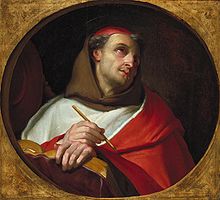
Elias, who had been excommunicated and taken under the protection ofFrederick II,was now forced to give up all hope of recovering his power in the Order. He died in 1253, after succeeding by recantation in obtaining the removal of his censures. Under John of Parma, who enjoyed the favor of Innocent IV andPope Alexander IV,the influence of the Order was notably increased, especially by the provisions of the latter pope in regard to the academic activity of the brothers. He not only sanctioned the theological institutes in Franciscan houses, but did all he could to support the friars in the Mendicant Controversy, when the secular Masters of theUniversity of Parisand the Bishops of France combined to attack themendicant orders.It was due to the action ofAlexander IV's envoys, who were obliged to threaten the university authorities with excommunication, that the degree of doctor of theology was finally conceded to theDominicanThomas Aquinasand the FranciscanBonaventure(1257), who had previously been able to lecture only as licentiates.
The FranciscanGerard of Borgo San Donninoat this time issued a Joachimite tract andJohn of Parmawas seen as favoring the condemned theology ofJoachim of Fiore.To protect the Order from its enemies, John was forced to step down and recommended Bonaventure as his successor. Bonaventure saw the need to unify the Order around a common ideology and both wrote a new life of the founder and collected the Order's legislation into the Constitutions of Narbonne, so called because they were ratified by the Order at its chapter held atNarbonne,France, in 1260. In the chapter ofPisathree years later Bonaventure'sLegenda maiorwas approved as the only biography of Francis and all previous biographies were ordered to be destroyed. Bonaventure ruled (1257–74) in a moderate spirit, which is represented also by various works produced by the order in his time – especially by theExpositio regulaewritten byDavid of Augsburgsoon after 1260.
14th century[edit]
1274–1300[edit]
The successor to Bonaventure, Jerome of Ascoli or Girolamo Masci (1274–79), (the futurePope Nicholas IV), and his successor,Bonagratia of Bologna(1279–85), also followed a middle course. Severe measures were taken against certain extremeSpiritualswho, on the strength of the rumor thatPope Gregory Xwas intending at theCouncil of Lyon(1274–75) to force the mendicant orders to tolerate the possession of property, threatened both pope and council with the renunciation of allegiance. Attempts were made, however, to satisfy the reasonable demands of the Spiritual party, as in the bullExiit qui seminat[25]ofPope Nicholas III(1279), which pronounced the principle of complete poverty to be meritorious and holy, but interpreted it in the way of a somewhat sophistical distinction between possession and usufruct. The bull was received respectfully by Bonagratia and the next two generals,Arlotto of Prato(1285–87) andMatthew of Aqua Sparta(1287–89); but the Spiritual party under the leadership of the Bonaventuran pupil and apocalypticPierre Jean Oliviregarded its provisions for the dependence of the friars upon the pope and the division between brothers occupied in manual labor and those employed on spiritual missions as a corruption of the fundamental principles of the Order. They were not won over by the conciliatory attitude of the next general,Raymond Gaufredi(1289–96), and of the Franciscan Pope Nicholas IV (1288–92). The attempt made by the next pope,Celestine V,an old friend of the order, to end the strife by uniting the Observantist party with his own order of hermits (seeCelestines) was scarcely more successful. Only a part of the Spirituals joined the new order, and the secession scarcely lasted beyond the reign of the hermit-pope.Pope Boniface VIIIannulled Celestine's bull of foundation with his other acts, deposed the generalRaymond Gaufredi,and appointed a man of laxer tendency,John de Murro,in his place. The Benedictine section of the Celestines was separated from the Franciscan section, and the latter was formally suppressed by Pope Boniface VIII in 1302. The leader of the Observantists, Olivi, who spent his last years in the Franciscan house at Tarnius and died there in 1298, had pronounced against the extremer "Spiritual" attitude, and given an exposition of the theory of poverty which was approved by the more moderate Observantists, and for a long time constituted their principle.
Persecution[edit]
UnderPope Clement V(1305–14) this party succeeded in exercising some influence on papal decisions. In 1309 Clement had a commission sit atAvignonfor the purpose of reconciling the conflicting parties.Ubertino of Casale,the leader, after Olivi's death, of the stricter party, who was a member of the commission, induced theCouncil of Vienneto arrive at a decision in the main favoring his views, and the papal constitutionExivi de paradiso(1313) was on the whole conceived in the same sense. Clement's successor,Pope John XXII(1316–34), favored the laxer or conventual party. By the bullQuorundam exigithe modified several provisions of the constitutionExivi,and required the formal submission of the Spirituals. Some of them, encouraged by the strongly Observantist generalMichael of Cesena,ventured to dispute the pope's right so to deal with the provisions of his predecessor. Sixty-four of them were summoned to Avignon and the most obstinate delivered over to the Inquisition, four of them being burned (1318). Shortly before this all the separate houses of the Observantists had been suppressed.
Renewed controversy on the question of poverty[edit]

A few years later a new controversy, this time theoretical, broke out on the question ofpoverty.In his 14 August 1279 bullExiit qui seminat,[26]Pope Nicholas IIIhad confirmed the arrangement already established byPope Innocent IV,by which all property given to the Franciscans was vested in theHoly See,which granted the friars the mere use of it. The bull declared that renunciation of ownership of all things "both individually but also in common, for God's sake, is meritorious and holy; Christ, also, showing the way of perfection, taught it by word and confirmed it by example, and the first founders of the church militant, as they had drawn it from the fountainhead itself, distributed it through the channels of their teaching and life to those wishing to live perfectly."[27][28][29]
AlthoughExiit qui seminatbanned disputing about its contents, the decades that followed saw increasingly bitter disputes about the form of poverty to be observed by Franciscans, with the Spirituals (so called because associated with the Age of the Spirit thatJoachim of Fiorehad said would begin in 1260)[30]pitched against theConventual Franciscans.[31]Pope Clement V's bullExivi de Paradisoof 20 November 1312[32]failed to effect a compromise between the two factions.[30]Clement V's successor,Pope John XXIIwas determined to suppress what he considered to be the excesses of the Spirituals, who contended eagerly for the view that Christ and his apostles had possessed absolutely nothing, either separately or jointly, and who were citingExiit qui seminatin support of their view.[33]In 1317, John XXII formally condemned the group of them known as the Fraticelli.[30]On 26 March 1322, withQuia nonnunquam,he removed the ban on discussion of Nicholas III's bull[34][35]and commissioned experts to examine the idea of poverty based on belief that Christ and the apostles owned nothing. The experts disagreed among themselves, but the majority condemned the idea on the grounds that it would condemn the church's right to have possessions.[30]The Franciscan chapter held inPerugiain May 1322 declared on the contrary: "To say or assert that Christ, in showing the way of perfection, and the Apostles, in following that way and setting an example to others who wished to lead the perfect life, possessed nothing either severally or in common, either by right of ownership anddominiumor by personal right, we corporately and unanimously declare to be not heretical, but true and catholic. "[30]By the bullAd conditorem canonumof 8 December 1322,[36]John XXII, declaring it ridiculous to pretend that every scrap of food given to the friars and eaten by them belonged to the pope, refused to accept ownership over the goods of the Franciscans in the future and granted them exemption from the rule that absolutely forbade ownership of anything even in common, thus forcing them to accept ownership.[37]And, on 12 November 1323, he issued the short bullQuum inter nonnullos[38]which declared "erroneous and heretical" the doctrine that Christ and his apostles had no possessions whatever.[29][33][39]John XXII's actions thus demolished the fictitious structure that gave the appearance of absolute poverty to the life of the Franciscan friars.[40]
Influential members of the order protested, such as the minister generalMichael of Cesena,the English provincialWilliam of Ockham,andBonagratia of Bergamo.In 1324,Louis the Bavariansided with the Spirituals and accused the pope of heresy. In reply to the argument of his opponents that Nicholas III's bullExiit qui seminatwas fixed and irrevocable, John XXII issued the bullQuia quorundamon 10 November 1324[41]in which he declared that it cannot be inferred from the words of the 1279 bull that Christ and the apostles had nothing, adding: "Indeed, it can be inferred rather that the Gospel life lived by Christ and the Apostles did not exclude some possessions in common, since living 'without property' does not require that those living thus should have nothing in common." In 1328, Michael of Cesena was summoned to Avignon to explain the Order's intransigence in refusing the pope's orders and its complicity with Louis of Bavaria. Michael was imprisoned in Avignon, together with Francesco d'Ascoli, Bonagratia, and William of Ockham. In January of that year Louis of Bavaria entered Rome and had himself crowned emperor. Three months later he declared John XXII deposed and installed the Spiritual FranciscanPietro Rainalducciasantipope.The Franciscan chapter that opened inBolognaon 28 May reelected Michael of Cesena, who two days before had escaped with his companions from Avignon. But in August Louis the Bavarian and his pope had to flee Rome before an attack byRobert, King of Naples.Only a small part of the Franciscan Order joined the opponents of John XXII, and at a general chapter held inParisin 1329 the majority of all the houses declared their submission to the Pope. With the bullQuia vir reprobusof 16 November 1329,[42]John XXII replied to Michael of Cesena's attacks onAd conditorem canonum,Quum inter nonnullos,andQuia quorundam.In 1330, Antipope Nicholas V submitted, followed later by the ex-general Michael, and finally, just before his death, by Ockham.[30]
Separate congregations[edit]

Out of all these dissensions in the 14th century sprang a number of separate congregations, or almost sects, to say nothing of the heretical parties of theBeghardsandFraticelli,some of which developed within the Order on both hermit and cenobitic principles and may here be mentioned:
Clareni[edit]
The Clareni or Clarenini was an association of hermits established on the river Clareno in the march ofAnconabyAngelo da Clareno(1337). Like several other smaller congregations, it was obliged in 1568 underPope Pius Vto unite with the general body of Observantists.
Minorites of Narbonne[edit]
As a separate congregation, this originated through the union of a number of houses which followed Olivi after 1308. It was limited to southwestern France and, its members being accused of the heresy of the Beghards, was suppressed by the Inquisition during the controversies under John XXII.
Reform of Johannes de Vallibus[edit]

This was founded in the hermitage of St. Bartholomew at Brugliano nearFolignoin 1334. The congregation was suppressed by the Franciscan general chapter in 1354; reestablished in 1368 by Paolo de' Trinci of Foligno; confirmed by Gregory XI in 1373, and spread rapidly from Central Italy to France, Spain, Hungary, and elsewhere. Most of the Observantist houses joined this congregation by degrees, so that it became known simply as the "brothers of the regular Observance." It acquired the favor of the popes by its energetic opposition to the hereticalFraticelli,and was expressly recognized by theCouncil of Constance(1415). It was allowed to have a special vicar-general of its own and legislate for its members without reference to the conventual part of the Order. Through the work of such men asBernardino of Siena,Giovanni da Capistrano,andDietrich Coelde(b. 1435? at Munster; was a member of theBrethren of the Common Life,died December 11, 1515), it gained great prominence during the 15th century. By the end of the Middle Ages, the Observantists, with 1,400 houses, comprised nearly half of the entire Order. Their influence brought about attempts at reform even among the Conventuals, including the quasi-Observantist brothers living under the rule of the Conventual ministers (Martinianists orObservantes sub ministris), such as the male Colletans, later led by Boniface de Ceva in his reform attempts principally in France and Germany; the reformed congregation founded in 1426 by the Spaniard Philip de Berbegal and distinguished by the special importance they attached to the little hood (cappuciola); the Neutri, a group of reformers originating about 1463 in Italy, who tried to take a middle ground between the Conventuals and Observantists, but refused to obey the heads of either, until they were compelled by the pope to affiliate with the regular Observantists, or with those of the Common Life; the Caperolani, a congregation founded about 1470 in North Italy byPeter Caperolo,but dissolved again on the death of its founder in 1481; the Amadeists, founded by the noble Portuguese Amadeo, who entered the Franciscan order at Assisi in 1452, gathered around him a number of adherents to his fairly strict principles (numbering finally twenty-six houses), and died in the odor of sanctity in 1482.
Unification[edit]

Projects for a union between the two main branches of the Order were put forth not only by the Council of Constance but by several popes, without any positive result. By direction ofPope Martin V,John of Capistranodrew up statutes which were to serve as a basis for reunion, and they were actually accepted by a general chapter at Assisi in 1430; but the majority of the Conventual houses refused to agree to them, and they remained without effect. AtJohn of Capistrano's requestEugene IVissued a bull (Ut sacra minorum,1446) aimed at the same result, but again nothing was accomplished. Equally unsuccessful were the attempts of the FranciscanPope Sixtus IV,who bestowed a vast number of privileges on both of the original mendicant orders, but by this very fact lost the favor of the Observants and failed in his plans for reunion.Julius IIsucceeded in reducing some of the smaller branches, but left the division of the two great parties untouched. This division was finally legalized byLeo X,after a general chapter held in Rome in 1517, in connection with the reform-movement of theFifth Lateran Council,had once more declared the impossibility of reunion. The less strict principles of the Conventuals, permitting the possession of real estate and the enjoyment of fixed revenues, were recognized as tolerable, while the Observants, in contrast to thisusus moderatus,were held strictly to their ownusus arctusorpauper.
All of the groups that followed the Franciscan Rule literally were united to the Observants, and the right to elect theMinister General of the Order,together with the seal of the Order, was given to this united grouping.[when?]This grouping, since it adhered more closely to the rule of the founder, was allowed to claim a certain superiority over the Conventuals. The Observant general (elected now for six years, not for life) inherited the title of "Minister-General of the Whole Order of St. Francis" and was granted the right to confirm the choice of a head for the Conventuals, who was known as "Master-General of the Friars Minor Conventual" —although this privilege never became practically operative.
New World missions[edit]

The work of the Franciscans in New Spain began in 1523, when three Flemish friars—Juan de Ayora, Pedro de Tecto, and Pedro de Gante—reached the central highlands. Their impact as missionaries was limited at first, since two of them died onCortés's expedition to Central America in 1524, but Fray Pedro de Gante initiated the evangelization process and studied theNahuatl languagethrough his contacts with children of the Indian elite from the city ofTetzcoco.[43]Later, in May 1524, with the arrival of theTwelve Apostles of Mexico,led byMartín de Valencia.There they built theConvento Grande de San Francisco,[44]which became Franciscan headquarters forNew Spainfor the next three hundred years.
Franciscans and the Inquisition[edit]
About 1236, Pope Gregory IX appointed the Franciscans, along with the Dominicans, as Inquisitors.[45]The Franciscans had been involved in anti-heretical activities from the beginning simply by preaching and acting as living examples of the Gospel life.[46]As official Inquisitors, they were authorized to use torture to extract confessions, as approved by Pope Innocent IV in 1252.[45]The Franciscans were involved in the torture and trials of Jews, Muslims, and other heretics[47]throughout the Middle Ages and wrote their own manuals to guide Inquisitors, such as the 14th centuryCodex Casanatensisfor use by Inquisitors in Tuscany.[48]
Some 300,000 Jews, up to a quarter of the Spanish population, had to convert to Catholicism or flee Spain, or were killed in theSpanish Inquisition.The Inquisition spread to the new world during theAge of Discoveryto root out heretics, leading further persecution and execution (e.g.,Mexican Inquisition).[49]
Contemporary organizations[edit]
First Order[edit]
Order of Friars Minor[edit]
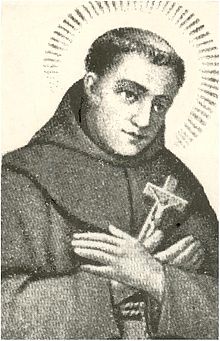
TheOrder of Friars Minor(OFM) has 1,500 houses in about 100 provinces andcustodiae,with about 16,000 members. In 1897,Pope Leo XIIIcombined the Observants,Discalced(Alcantarines), Recollects, and Riformati into one order under general constitutions. While the Capuchins and Conventuals wanted the reunited Observants to be referred to as The Order of Friars Minor of the Leonine Union, they were instead called simply theOrder of Friars Minor.Despite the tensions caused by this forced union the Order grew from 1897 to reach a peak of 26,000 members in the 1960s before declining after the 1970s. The Order is headed by a Minister General, who since July 2021 is Father Massimo Fusarelli.[50]
Order of Friars Minor Conventual[edit]
TheOrder of Friars Minor Conventual(OFM Conv.) consists of 290 houses worldwide with a total of almost 5000 friars. They have experienced growth in this century throughout the world. They are located in Italy, the United States, Canada, Australia, and throughout Latin America, and Africa. They are the largest in number in Poland because of the work and inspiration ofMaximilian Kolbe.
Order of Friars Minor Capuchin[edit]

TheOrder of Friars Minor Capuchin(OFM Cap.) are the youngest branch of Franciscans, founded in 1525 by Matteo Serafini (Matteo Bassi,Matteo da Bascio), an Observant friar, who felt himself called to an even stricter observance of Franciscan austerity. With the support of the Papal Court, the new branch received early recognition and grew fast, first in Italy and after 1574 all over Europe and throughout the world. The Capuchins eventually became a separate order in 1619. The name Capuchins refers to the particular shape of the long hood orcapuce;originally a popular nickname, it has become a part of the official name of the order. The order now exists in 106 countries all over the world, with around 10,500 brothers living in more than 1700 communities known as fraternities or friaries.
Second Order[edit]
Poor Clares[edit]
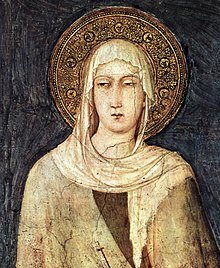
ThePoor Clares,officially theOrder of Saint Clare,are members of acontemplative orderofnunsin theCatholic Church.The Poor Clares were the secondFranciscanorder to be established. Founded byClare of AssisiandFrancis of AssisionPalm Sundayin the year 1212, they were organized after theOrder of Friars Minor(the first order), and before the Third Order of Saint Francis. As of 2011 there were over 20,000 Poor Clare nuns in over 75 countries throughout the world. They follow several different observances and are organized into federations.[51]
The Poor Clares follow theRule of St. Clarewhich was approved by PopeInnocent IVthe day before Clare's death in 1253. The main branch of the Order (OSC) follows the observance of Pope Urban. Other branches established since that time, who operate under their own uniqueconstitutions,are theColettine Poor Clares(PCC– founded 1410), theCapuchin Poor Clares(OSC Cap.– founded 1538), and thePoor Clares of Perpetual Adoration(PCPA– founded 1854).
Third Order[edit]

TheThird Order of Saint Franciscomprises people who desired to grow in holiness in their daily lives without enteringmonasticlife. After founding the Friars Minor and seeing a need, Francis created a way of life to which married men and women, as well as the single and thesecular clergy,could belong and live according to the Gospel.
Secular Franciscan Order[edit]
TheSecular Franciscan Order,prior to 1978 also known as the Third Order Secular of Saint Francis, is an order founded by Francis in 1212 for brothers and sisters who do not live in a religious community. Members of the order continue to live secular lives, however they do gather regularly for fraternal activities. In the United States alone there are 17,000 professed members of the order. Members of the Order live according to a Rule composed by St Francis in 1221. The Rule was slightly modified through the centuries and was replaced at the turn of the 20th century byPope Leo XIII,himself a member of the Order. A new and current Rule was approved byPope Paul VIin 1978, and the Third Order was renamed the Secular Franciscan Order. It is an international organization with its ownMinister Generalbased in Rome.
Third Order Regular[edit]
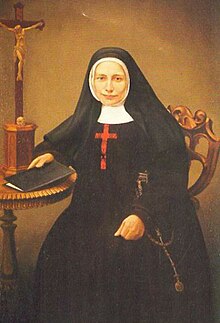
Within a century of the death of Francis, members of the Third Order began to live in common, in an attempt to follow a moreasceticalway of life.Angela of Foligno(+1309) was foremost among those who achieved great depths in their lives of prayer and service of the poor, while living in community with other women of the Order.
Among the men, theThird Order Regular of St. Francis of Penance[52]was formed in 1447 by a papal decree that united several communities ofhermitsfollowing the Third OrderRuleinto a single Order with its own Minister General. Today it is an international community of friars who desire to emphasize the works of mercy and on-going conversion. The community is also known as the Franciscan Friars,TOR,and they strive to "rebuild the Church" in areas of high school and college education, parish ministry, church renewal, social justice, campus ministry, hospital chaplaincies, foreign missions, and other ministries in places where the church is needed.[53]The association of Franciscans (Grey Friars) with education becomes a stock fictional reference in (for example) the works ofThackeray( "Grey Friars School" inPendennisandThe Newcomes) or of"Frank Richards"(Greyfriars SchoolofBilly Bunterfame).
After the formal recognition of the members of religious tertiary communities, the following centuries saw a steady growth of such communities across Europe. Initially, the women's communities took a monastic form of life, either voluntarily or under pressure fromecclesiasticalsuperiors. The great figure of this development wasHyacintha Mariscotti.As Europe entered the upheavals of the modern age, new communities arose which were able to focus more exclusively on social service, especially during the immediate post-Napoleonicperiod which devastated much of Western Europe. An example of this isMary Frances Schervier(1819–1876).
Third Order Regular in North America[edit]
This movement continued in North America as various congregations arose from one coast to another, in answer to the needs of the large emigrant communities that were flooding the cities of the United States and Canada.
The Third Order Regular of theBrothers of the Poor of St. Francis of Assisi,CFP,are an active community, based in the United States, with houses in Belgium, The Netherlands, Germany, and Brazil. These Franciscans strive to live an integrated life through prayer, community, and ministry to the poor, neglected and disadvantaged youth, the powerless, people in need, and the elderly. The Brothers of the Poor live by their vows of poverty (living a simple lifestyle), consecrated chastity (loving all, possessing no one, striving sincerely, forsingleness of heart,a celibate way of loving and being loved), and obedience (to God, to the community, to the church, and to self). The Brothers of the Poor also serve persons with AIDS and people who ask for help, regardless of their religion or their social/economic background. They are teachers, childcare workers, social workers, counselors, pastoral ministers, retreat ministers, religious educators, and school administrators, along with other tasks.
The Regular Tertiaries, officially the Third Order Regular of St. Francis of Penance, who operate theFranciscan University of Steubenville,follow a rule approved byPope Leo X.Today this group is present in 17 countries: Italy, Croatia, Spain, France, Germany, Austria, US, India, Sri Lanka, South Africa, Brazil, Paraguay, Mexico, Peru, Sweden, Bangladesh, and the Philippines.[54]
Brothers and Sisters of Penance of St. Francis[edit]

TheBrothers and Sisters of Penance of St. Francis,is a private confraternity of the Catholic Church whose members strive to model their lives according to the Rule and Statutes of the Primitive Rule of the Third Order of St. Francis, which was written for lay people in 1221 by Francis of Assisi. Right now there are several hundred members within the United States and a few hundred more throughout the world. The order was originally started in 1996 by members of the Archdiocese of St. Paul in Minnesota.
Other tertiaries[edit]
- In 1435,Francis of Paolafounded the "Poor Hermits of Saint Francis of Assisi", later known as the "Hermits of the Order ofMinims",and then renamed the" Order of Minims "in 1506 by PopeJulius II.There are mendicant friars, contemplative nuns, and lay tertiaries.
- The Society of the Atonement, also known asGraymoor FriarsandGraymoor Sisters,started in 1898 as a religious community in theEpiscopal Church,and came into union with theHoly Seein 1909.
- TheFranciscan Friars of the Immaculatestarted in 1970, and became an institute with Pontifical Right in 1998. In that same year, the Franciscan Sisters of the Immaculate also became an institute with Pontifical Right. There are also Third Order Franciscan Sisters of the Immaculate, an offshoot of the Franciscan Tertiaries of the Immaculate.
Other Franciscan organizations[edit]
- The Community of theFranciscan Friars of the Renewalstarted in 1987, and the Franciscan Sisters of the Renewal in 1988.
- TheFranciscan Missionaries of the Eternal Wordstarted in 1987, and are now a Public Clerical Association of the Faithful.
- Franciscans International[55]is aNon-governmental organization(NGO) with General Consultative status at theUnited Nations,uniting the voices of Franciscan brothers and sisters from around the world. It operates under the sponsorship of the Conference of the Franciscan Family (CFF) and serves all Franciscans and the global community by bringing grassroots Franciscans to the United Nations forums in New York City and Geneva. It brings the spiritual and ethical values of the Franciscans to the United Nations and international organisations.
Other Christian traditions[edit]
One of the results of theOxford Movementin theAnglican Churchduring the 19th century was the re-establishment of religious orders, including some of Franciscan inspiration. The principal Anglican communities in the Franciscan tradition are theCommunity of St. Francis(women, founded 1905) (CSF), the Poor Clares of Reparation (PCR), theSociety of Saint Francis(men, founded 1934)(SSF), theCommunity of St. Clare(women, enclosed) (OSC), and theOrder of St. Francis(men, founded in 2003). There is also aThird Orderknown as the Third Order Society of St Francis (TSSF), and theLesser Franciscans.
There is also an order of Sisters of St. Clare in thePuget Soundarea ofWashington state(Diocese of Olympia), the Little Sisters of St. Clare.[56]
There are further some small Franciscan communities within EuropeanProtestantismand theOld Catholic Church.[57]There are someFranciscan orders in Lutheran Churches,including theOrder of Lutheran Franciscans,theEvangelical Sisterhood of Mary,and the Evangelische Kanaan Franziskus-Bruderschaft (Kanaan Franciscan Brothers).
In addition, there are associations of Franciscan inspiration not connected with a mainstream Christian tradition and describing themselves as ecumenical or dispersed. The Companions of Francis Apostolic Religious Institute (CFARI), with its roots in independent Catholicism and Anglicanism, is a dispersed, egalitarian and ecumenical order of Franciscans based in Pasadena, California, with vowed members in California, Arizona and New Mexico. CFARI members live among the populations they serve and are self supporting in their ministry.
Distinguishing characteristics[edit]
Spirituality[edit]
Franciscan theology conforms to broaderdoctrinewith the Catholic Church, but involves several unique emphases. Franciscan theologians view creation, the natural world, as good and joyous, and avoid dwelling on the "stain oforiginal sin."Francis expressed great affection towards animals and inanimate natural objects as fellow inhabitants of God's creation, in his workCanticle of the Creatures(Laudes Creaturarum,also known as theCanticle of the Sun). Special emphasis is put on theIncarnation of Christviewed as a special act of humility, as Francis was struck by God's great charity in sacrificing his son for our salvation; they also exhibit great devotion to theEucharist.The Rule of Saint Francis calls for members to practice simple living and detachment from material possessions in emulation of Jesus' life and earthly ministry. The simple lifestyle helps members of the order, in whichever branch, to experience solidarity with the poor and to work for social justice. Franciscan spirituality also strongly emphasizes working to preserve the church, and remain loyal to it.[58][59]
Visions and stigmata[edit]

Among Catholic religious, Franciscans have proportionally reported higher ratios ofstigmataand have claimed proportionally higher ratios ofvisions of Jesus and Mary.[citation needed]Francis of Assisihimself was one of the first reported cases of stigmata, and perhaps the most famous stigmatic of modern times isPadre Pio,a Capuchin, who also reported visions of Jesus and Mary. Pio's stigmata persisted for over fifty years and he was examined by numerousphysiciansin the 20th century, who confirmed the existence of the wounds, but none of whom could produce a medical explanation for the fact that his bleeding wounds would never getinfected.According to theEncyclopaedia Britannica,his wounds healed once, but reappeared.[60]According to theColumbia Encyclopedia[61][better source needed]some medical authorities who examined Padre Pio's wounds were inclined to believe that the stigmata were connected with nervous or cataleptichysteria.According toAnswers.com[62][better source needed]the wounds were examined by Luigi Romanelli, chief physician of the City Hospital of Barletta, for about one year;Giorgio Festa,a private practitioner who examined them in 1920 and 1925;Giuseppe Bastianelli,a physician toPope Benedict XV,who agreed that the wounds existed but made no other comment; and pathologistAmico Bignamiwho also observed the wounds but made nodiagnosis.
Contributions to biblical scholarship[edit]
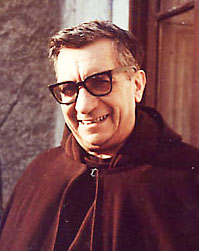
The Franciscans established theStudium Biblicum Franciscanumas anacademic societybased in Jerusalem andHong Kongfor the study of scripture. The Hong Kong branch founded byGabriele Allegraproduced the first complete translation of the Catholic Bible in Chinese in 1968 after a 40-year effort.[63]TheStudium Biblicum Translationis often considered the authoritative Chinese Bible among Catholics.
The early efforts of another Franciscan, namelyGiovanni di Monte Corvinowho had attempted a first translation of the Bible inBeijingin the 14th century, provided the initial spark for Gabriele Allegra's 40 year undertaking, when at the age of 21 he happened to attend the 6th centenary celebration for Monte Corvino.
Notable members[edit]
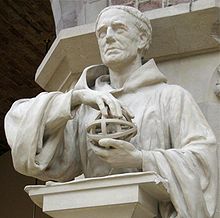
The Franciscan order boasts a number of distinguished members. From its first century can be cited the three great scholasticsAlexander of Hales,Bonaventure,andJohn Duns Scotus,the "Doctor of Wonders"Roger Bacon,and the well-known mystic authors and popular preachersDavid of AugsburgandBerthold of Regensburg.
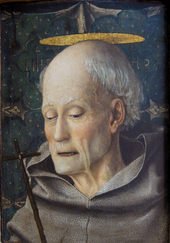
During the Middle Ages noteworthy members includedNicholas of Lyra,Biblical commentatorBernardino of Siena,philosopherWilliam of Ockham,preachersJohn of Capistrano,Oliver Maillard,andMichel Menot,and historiansLuke WaddingandAntoine Pagi.
In the field of Christian art during the later Middle Ages, the Franciscan movement exercised considerable influence, especially in Italy. The influence of Franciscan ideals shows in several great painters of the 13th and 14th centuries, especiallyCimabueandGiotto,who, though they were not friars, were spiritual sons of Francis in the wider sense; it is also seen in the plastic masterpieces of the latter, as well as the architectural conceptions of both himself and his school. The Italian Gothic style, whose earliest important monument is the great convent church atAssisi(built 1228–53), was cultivated as a rule principally by members of the order or men under their influence.
The early spiritual poetry of Italy was partially inspired by Francis himself, who was followed byThomas of Celano,Bonaventure,andJacopone da Todi.Through a tradition which held him to have been a member of the Franciscan Third Order, evenDantemay be included within this artistic tradition (cf. especiallyParadiso,xi. 50).
Other famous members of the Franciscan family includeAnthony of Padua,François Rabelais,Alexander of Hales,Giovanni da Pian del Carpini,Pio of Pietrelcina,Maximilian Kolbe,Pasquale Sarullo,Mamerto Esquiú,Gabriele Allegra,Junipero Serra,Simpliciano of the Nativity,Mychal F. Judge,Angelico Chavez,Anton Docher,Joseph of Cupertino,Benedict GroeschelandLeonard of Port Maurice.
During the "spiritual conquest" of New Spain, 1523–1572, the arrival of the first group of Franciscans, theTwelve Apostles of Mexico,includedMartín de Valencia,but more prominently for his corpus of writings on the earliest years wasToribio de Benavente Motolinia.Other important Franciscans areAlonso de Molina,Andrés de Olmos,andBernardino de Sahagún,who all created texts in indigenous language ofNahuatlto aid friars in theevangelization of Mexico.Geronimo de Mendieta,Augustin de Vetancourt,andJuan de Torquemadaare important contributors to thehistory of the Franciscans in central Mexico.[64]
A modern notable member includesCasey Cole,an AmericanFranciscanfriar,Catholic priest,writer, and blogger. Cole runs his own online blog and YouTube channel[65]calledBreaking in the Habit[66]and is the author of the booksLet Go: Seven Stumbling Blocks to Christian DiscipleshipandCalled: What Happens After Saying Yes to God.[67][68]
See also[edit]
- Alonso de Posada(1626-?), Spanish missionary inNew Mexico
- Association of Franciscan Colleges and Universities
- List of ministers general of the Order of Friars Minor
- Maria Antonio of Vicenza
- List of Franciscan saints
- Francis of AssisiThe founder of Franciscans.
- Supply of Franciscan missions in New Mexico
References[edit]
Notes[edit]
- ^abc"Do the Franciscans have a coat or arms like many other religious orders?".Franciscan Friars: Province of Santa Barbara. Archived fromthe originalon 2014-02-22.
- ^abcd"Order of Friars Minor (O.F.M.)".
- ^"Franciscan | Definition, History, & Facts | Britannica".Encyclopedia Britannica.2024-01-18.Retrieved2024-02-25.
- ^"Community of Francis and Clare".Community of Francis and Clare.Retrieved2022-05-09.
- ^"Franciscans, Religious Order".Encyclopaedia Britannica.26 February 2013.Retrieved7 January2017.
- ^"Saint Francis of Assisi, Italian Saint".Encyclopaedia Britannica.26 February 2013.Retrieved7 January2017.
- ^Bihl, Michael (1913)..In Herbermann, Charles (ed.).Catholic Encyclopedia.New York: Robert Appleton Company.
- ^Schwaller, John F. (2014). "Francis of Assisi: The Life by Augustine Thompson, O.P. (review)".The Americas.71(2): 379–380.doi:10.1353/tam.2014.0136.S2CID142650555.Project MUSE555981.
- ^"All Saints of the Seraphic Order (Feast)".Catholic News Agency.
- ^abcde"The rule of the Franciscan Order from the Medieval Sourcebook".Fordham.edu. 1999-09-22. Archived fromthe originalon 2013-05-27.Retrieved2013-06-16.
- ^Paschal Robinson (1913)..In Herbermann, Charles (ed.).Catholic Encyclopedia.New York: Robert Appleton Company.
- ^abcdPaschal Robinson (1913)..In Herbermann, Charles (ed.).Catholic Encyclopedia.New York: Robert Appleton Company.
- ^SeeAlberzoni, Maria Pia (2004).Clare of Assisi and the Poor Sisters in the Thirteenth Century.St. Bonaventure, NY: Franciscan Institute.ISBN978-1576591956.
- ^Annuario Pontificio per l'anno 2022(Citta del Vaticano: Libreria Editrice Vaticana, 2022, pp. 1386–1387.
- ^Paschal Robinson (1913)..In Herbermann, Charles (ed.).Catholic Encyclopedia.New York: Robert Appleton Company.
- ^"Catholic Encyclopedia: Rule of Saint Francis".www.newadvent.org.Retrieved2020-04-19.
- ^Chesterton (1924), pp. 107–108
- ^Galli (2002), pp. 74–80
- ^abRobinson, Paschal. "Elias of Cortona." The Catholic EncyclopediaArchived2019-12-29 at theWayback MachineVol. 5. New York: Robert Appleton Company, 1909. 28 December 2019
 This article incorporates text from this source, which is in thepublic domain.
This article incorporates text from this source, which is in thepublic domain.
- ^""Brother Elia of Cortona", Basilica Papale e Sacro convent di San Francesco in Assisi ".Archived fromthe originalon 2019-07-09.Retrieved2019-12-29.
- ^Greyfriars in EnglandArchived2008-07-05 at theWayback Machine
- ^"Franciscan Custody of the Holy Land".Christusrex.org. Archived fromthe originalon 2013-06-15.Retrieved2013-06-16.
- ^Robinson, Paschal. "Brother Leo." The Catholic EncyclopediaArchived2019-12-05 at theWayback MachineVol. 9. New York: Robert Appleton Company, 1910. 28 December 2019
 This article incorporates text from this source, which is in thepublic domain.
This article incorporates text from this source, which is in thepublic domain.
- ^"Order of Friars Minor".newadvent.org.
- ^"Exiit qui seminat".August 14, 1279. Archived fromthe originalon July 3, 2019.RetrievedJanuary 5,2020.
- ^Pope Nicholas III."English translation 2".Retrieved2013-06-16.
- ^English translation 1;Archived2011-11-01 at theWayback Machinecf.English translation 2and another translation in Rosalind B. Brooke,The Image of St Francis.Cambridge University Press, 2006ISBN978-0-521-78291-3,p. 98.
- ^"Origins of papal infallibility, 1150–1350: a study on the concepts of infallibility, sovereignty and tradition in the Middle Ages".Brill Archive. 1972.Retrieved2013-06-16.
- ^abKlaus Schatz,Papal Primacy.Collegeville, Minnesota: Liturgical Press. 1996. pp. 117–118.ISBN978-0814655221.Retrieved2013-06-16.
- ^abcdef"History of the Franciscan Movement (3)".Christusrex.org. 2001-12-30. Archived fromthe originalon 2013-05-22.Retrieved2013-06-16.
- ^Brooke,The Image of St Francis,p. 100
- ^"Exivi de Paradiso – Pope Clement V".franciscan-archive.org.Archived fromthe originalon January 12, 2012.
- ^abChristopher Kleinhenz (2003).Medieval Italy: An Encyclopedia.Vol. 1. Routledge. p. 373.ISBN978-0415939300.Retrieved2013-06-16.
- ^"John XXII, Quia nonnunquam".Archived fromthe originalon 2014-06-06.
- ^Brooke, p. 100
- ^"John XXII, Ad conditorem canonum".Archived fromthe originalon 2014-06-06.
- ^Brooke, pp. 100–101
- ^English translation 1Archived2013-06-06 at theWayback Machine;English translation 2
- ^"Tierney, p. 181".Retrieved2013-06-16.
- ^Brooke, p. 101
- ^English translation 1Archived2012-01-12 at theWayback Machine;English translation 2
- ^"John XXII, Quia vir reprobus".Archived fromthe originalon 2013-06-03.
- ^Nájera, Guillermo Antonio Nájera, and William B. Taylor. "Franciscans", inThe Oxford Encyclopedia of Mesoamerican Cultures,Oxford University Press, 2001.
- ^Chauvet, Fidel de J. (1950)."The Church of San Francisco in Mexico City".The Americas.7(1): 13–30.doi:10.2307/978514.JSTOR978514.S2CID144573605.
- ^ab"Catholic Encyclopedia – Inquisition".New Advent.Archivedfrom the original on October 26, 2007.RetrievedOctober 1,2018.
- ^Prudlo, Donald S.,The Origin, Development, and Refinement of Medieval Religious Mendicancies(Brill, 2011) p. 144
- ^"Witches in Religion".New Advent.Archived fromthe originalon August 12, 2018.RetrievedOctober 1,2018.
- ^Clement, Geoffrey Ward (2013).A Franciscan Inquisitor's Manual and its Compositional Context: 'Codex Casanatensis' 1730(PhD dissertation). Fordham University. pp. 1–372.ProQuest1410824809.Retrieved12 November2022.
- ^"The Auto-da-fé of Mexico City".Tablet Magazine.
- ^"Br. Massimo Fusarelli, new OFM Minister General".ofm.org.
- ^"Poor Clare Sisters".Archived fromthe originalon 23 December 2016.Retrieved9 December2016.
- ^"Third Order Regular".Francescanitor.org. 2013-05-12. Archived fromthe originalon 2013-06-09.Retrieved2013-06-16.
- ^"The Franciscan Orders".FranciscansTOR.org.Franciscan Friars, TOR. Archived fromthe originalon 2008-07-23.Retrieved2007-07-10.
- ^"Tertius Ordo Regularis Sancti Francisci | History".Archived fromthe originalon 2018-12-19.Retrieved2018-12-18.
- ^"Franciscans International".Franciscans International. 2013-04-10. Archived fromthe originalon 2013-07-23.Retrieved2013-06-16.
- ^"The Little Sisters of St. Clare".Archived fromthe originalon 2010-09-02.Retrieved2010-07-20.
- ^For example,the OSFOC[permanent dead link].
- ^"Living Simply".Franciscans in Action. Archived fromthe originalon 26 January 2017.Retrieved21 January2017."Franciscan Spirituality".Conventual Franciscans. Archived fromthe originalon 2017-01-03.Retrieved2017-01-22.
- ^"What is Franciscan Spirituality?".Saint Joseph Cupertino Fraternity, Secular Franciscan Order (OFS). 21 January 2014.Retrieved29 January2017.
- ^Britannica Online Encyclopedia,Padre PioArchived2007-09-29 at theWayback Machine
- ^"Bartleby.com: Great Books Online – Quotes, Poems, Novels, Classics and hundreds more".Archived fromthe originalon 2007-11-30.
- ^"Padre Pio: Biography and Much More from".Answers.com.Archivedfrom the original on 2013-05-12.Retrieved2013-06-16.
- ^"Studium Biblicum OFM".Archivedfrom the original on 2018-10-05.Retrieved2019-10-25.
- ^Handbook of Middle American Indians, Vol. 13: Guide to Ethnohistorical Sources, Pt. 2.Howard F. Cline(ed.). Austin: University of Texas Press, 1973, pp. 142–143, 186–239, 256–275.
- ^"Breaking In The Habit".YouTube.Retrieved2023-01-18.
- ^"Breaking In The Habit".Breaking In The Habit.Retrieved2023-01-18.
- ^Hayes, Maria (2019-02-20)."Priestly Ordination of Casey Cole Set for June 22".Holy Name Province.Archived fromthe originalon 2022-12-02.Retrieved2023-01-18.
- ^Hayes, Maria (2018-04-03)."Casey Cole Writes First Book".Holy Name Province.Archived fromthe originalon 2022-12-08.Retrieved2023-01-18.
Sources[edit]
Books
- Aguiar de Castro, José Acácio (1997).O simbolismo da natureza em Santo António de Lisboa.Biblioteca humanística e teológica (in Portuguese). Vol. 11. Porto: Universidade Católica Portugesa, Fundação Eng António de Almeida.ISBN978-9728386030.Retrieved31 May2016.
- Arnald of Sarrant(2010).Chronicle of the Twenty-Four Generals of the Order of Friars Minor.Translated by Noel Muscat. Malta: TAU Franciscan Communications.Retrieved31 May2016.
- Burr, David (2010).Spiritual Franciscans: From Protest to Persecution in the Century After Saint Francis.University Park, Pennsylvania: Pennsylvania State University Press.ISBN978-0-271-04138-4.Retrieved30 May2016.
- Camps, Arnulf; McCloskey, Patrick (1995).The Friars Minor in China (1294–1955): Especially the Years 1925–55, Based on the Research of Friars Bernward Willeke and Domenico Gandolfi, OFM.History series. Vol. 10. Franciscan Institute Publications.ISBN978-1-57659-002-7.Retrieved30 May2016.
- Carmody, Maurice (1994).The Leonine Union of the Order of Friars Minor: 1897.History series. Vol. 8. Franciscan Institute Publications.ISBN978-1-57659-084-3.Retrieved30 May2016.
- Carmody, Maurice (2008).The Franciscan Story.Athena Press.ISBN978-1-84748-141-2.Retrieved30 May2016.
- Cotter, Francis J. (1994). Roberta A. McKelvie (ed.).The Friars Minor in Ireland from their arrival to 1400.History series. Vol. 7. Franciscan Institute Publications.ISBN978-1-57659-083-6.Retrieved30 May2016.
- Couturier, David B. (2007).The Fraternal Economy: A Pastoral Psychology of Franciscan Economics.Cloverdale Books.ISBN978-1-929569-23-6.Retrieved30 May2016.
- Daniel, E. Randolph (1992).The Franciscan Concept of Mission in the High Middle Ages.Franciscan Pathways Series. Franciscan Institute Publications.ISBN978-1-57659-065-2.Retrieved30 May2016.
- Esser, Kajetan (1970).Origins of the Franciscan Order.Franciscan Herald Press.ISBN978-0-8199-0408-9.Retrieved30 May2016.
- Flood, David; Matura, Thaddée (1975).The Birth of a Movement: A Study of the First Rule of St. Francis.Franciscan Herald Press.ISBN978-0-8199-0567-3.Retrieved30 May2016.
- Francis of Assisi (1982).Francis and Clare: The Complete Works.Classics of Western spirituality. Translated by Regis J. Armstrong and Ignatius C. Brady. New York: Paulist Press.ISBN978-0809124466.Retrieved30 May2016.
- Francis of Assisi. Armstrong, Regis J.; Hellmann, J. A. Wayne; Short, William J. (eds.).Francis of Assisi: Early Documents.– 4 volumes
- The Saint.Francis of Assisi: Early Documents. Vol. 1 (2nd ed.). New City Press. 1999.ISBN978-0-904287-62-2.Retrieved30 May2016.
- The Founder.Francis of Assisi: Early Documents. Vol. 2 (Illustrated ed.). New City Press. 2000.ISBN978-1-56548-113-8.Retrieved30 May2016.
- The Prophet.Francis of Assisi: Early Documents. Vol. 3 (Annotated ed.). New City Press. 2001.ISBN978-1-56548-114-5.Retrieved30 May2016.
- Index.Francis of Assisi: Early Documents. Vol. 4 (Annotated ed.). New City Press. 2002.ISBN978-1-56548-172-5.Retrieved30 May2016.
- Gilliat-Smith, Ernest(1914).Saint Clare of Assisi: her life and legislation.London: J.M. Dent & Sons, Ltd. p.160.ISBN978-0665656316.Retrieved31 May2016.
- Lawrence, C.H. (2015).Medieval Monasticism: Forms of Religious Life in Western Europe in the Middle Ages.Medieval World Series (4th ed.). Routledge.ISBN978-1-317-50467-2.Retrieved30 May2016.
- Lynch, Cyprian J. (1988).A Poor Man's Legacy: An Anthology of Franciscan Poverty.Franciscan Pathways Series. Franciscan Institute.ISBN978-1-57659-069-0.Retrieved30 May2016.
- MacVicar, Thaddeus (1963).The Franciscan Spirituals and the Capuchin Reform.History series. Vol. 5. Franciscan Institute Publications.ISBN978-1-57659-086-7.Retrieved30 May2016.
- Merlo, Grado Giovanni (2009).In the Name of St. Francis: A History of the Friars Minor and Franciscanism until the Early Sixteenth Century.Translated by Robert J. Karris and Raphael Bonanno. Franciscan Institute Publications.ISBN978-1-57659-155-0.
- Moorman, John Richard Humpidge (1983).Medieval Franciscan houses.History series. Vol. 4. Franciscan Institute Publications.ISBN978-1-57659-079-9.Retrieved30 May2016.
- Moorman, John Richard Humpidge (1988).A History of the Franciscan Order: From Its Origins to the Year 1517.Franciscan Herald Press.ISBN978-0-8199-0921-3.Retrieved30 May2016.
- Osborne, Kenan B. (1994).The History of Franciscan Theology.Franciscan Institute Publications.ISBN978-1-57659-032-4.Retrieved30 May2016.
- Senocak, Neslihan (2012).The Poor and the Perfect: the rise of learning in the Franciscan order, 1209–1310.Ithaca, New York: Cornell University Press.ISBN978-0-8014-6471-3.Retrieved30 May2016.– Shows how Franciscans shifted away from an early emphasis on poverty and humility and instead emphasized educational roles
- Sharp, Dorothea Elizabeth (1966).Franciscan Philosophy at Oxford in the Thirteenth Century.British Society of Franciscan Studies. Vol. 16. Oxford University Press.ISBN978-0-576-99216-9.Retrieved30 May2016.
- Thomson, Williell R. (1975).Friars in the Cathedral: The First Franciscan Bishops 1226–1261.Studies and texts. Vol. 33. Toronto: Pontifical Institute of Mediaeval Studies.ISBN978-0888440334.ISSN0082-5328.Retrieved31 May2016.
- White, Joseph M. (2004).Peace and good in America: a history of Holy Name Province Order of Friars Minor, 1850s to the present(Illustrated ed.). Holy Name Province OFM.ISBN978-1-57659-196-3.Retrieved30 May2016.
Articles
- Halevi, Masha (2012). "Between Faith and Science: Franciscan Archaeology in the Service of the Holy Places".Middle Eastern Studies.48(2): 249–267.doi:10.1080/00263206.2012.653139.S2CID144234605.
- Schmucki, Oktavian (2000). "Die Regel des Johannes von Matha und die Regel des Franziskus von Assisi. Ähnlichkeiten und Eigenheiten. Neue Beziehungen zum Islam". In Cipollone, Giulio (ed.).La Liberazione dei 'Captivi' tra Cristianità e Islam: Oltre la Crociata e il Gihad: Tolleranza e Servizio Umanitario.Collectanea Archivi Vaticani. Vol. 46. Vatican City: Archivio Segreto Vaticano. pp. 219–244.
External links[edit]
First Order[edit]
- Order of Friars Minor(official website)
- Order of Friars Minor Capuchin(official website)
- Order of Friars Minor Conventual(official website)
Second Order[edit]
- Order of Saint Clare.Archived2021-09-16 at theWayback Machine(official website).
Third Order[edit]
- Secular Franciscan Order.Archived2014-08-30 at theWayback Machine(official website).
- Third Order Regular of St. Francis of Penance(official website)
Research resources[edit]
- Online guide to the Academy of American Franciscan History Microfilm Collection, 1526–1972,The Bancroft Library
- Franciscan authors, 13th – 18th centuryArchived2014-09-02 at theWayback Machine
- Digital FranciscansArchived2014-08-10 at theWayback Machine– extensive list of Franciscan internet resources
- Luke Wadding Papers: correspondence relating to Fr Luke Wadding OFM and the Irish Friars Minor at St. Isidore's College, Rome, on ecclesiastical and political matters; and concerning his interests as historian of the Franciscan Order.A UCD Digital Library Collection.
- Lewis E 253 Manuscript of an evangelist and prebendary of the minor orders at OPenn
- Lewis E 258 Life of Holy Francis and his companions at OPenn
- 14 Regulae ordinis fratrum minorum Franciscani etc. at OPenn
- Franciscan Society CollectionatUniversity College London
Media[edit]
- Greyfriars and Blackfriars,BBC Radio 4 discussion with Henrietta Leyser, Anthony Kenny & Alexander Murray (In Our Time,November 10, 2005)

